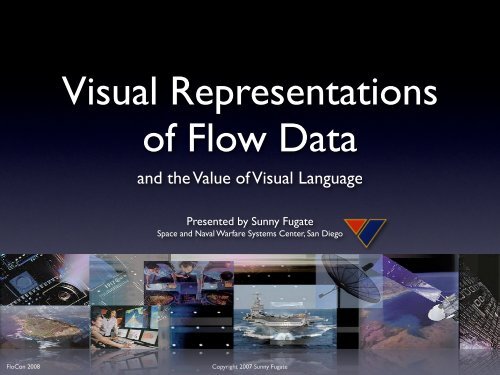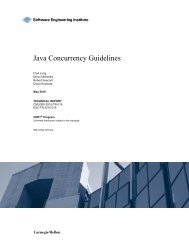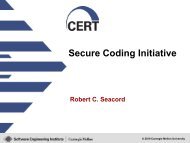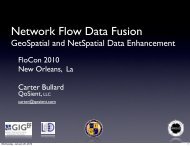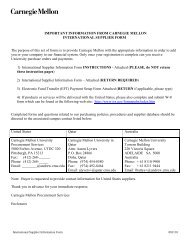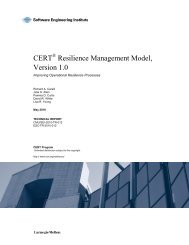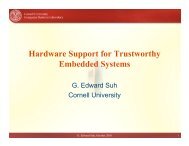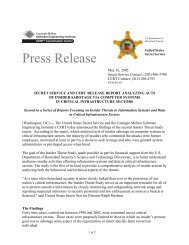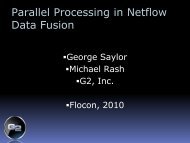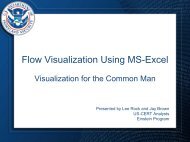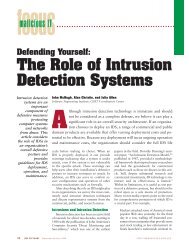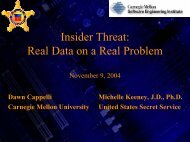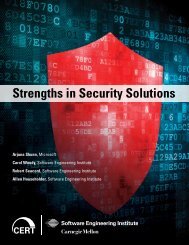and the Value of Visual Language - Cert
and the Value of Visual Language - Cert
and the Value of Visual Language - Cert
Create successful ePaper yourself
Turn your PDF publications into a flip-book with our unique Google optimized e-Paper software.
<strong>Visual</strong> Representations<br />
<strong>of</strong> Flow Data<br />
<strong>and</strong> <strong>the</strong> <strong>Value</strong> <strong>of</strong> <strong>Visual</strong> <strong>Language</strong><br />
Presented by Sunny Fugate<br />
Space <strong>and</strong> Naval Warfare Systems Center, San Diego<br />
FloCon 2008<br />
Copyright 2007 Sunny Fugate
Human-Machine Efficiency<br />
Over-Learned: Feedback<br />
}<br />
closed-loop : correct errors in production<br />
haptic<br />
{<br />
open-loop : correct errors in semantics<br />
visual / aural<br />
© 2007 Sunny Fugate
Human-Machine Efficiency<br />
Under-Learned: Representation<br />
FTP<br />
Server<br />
fast<br />
PCAP<br />
TXH1138<br />
arbitrary<br />
metaphor<br />
association<br />
representational<br />
indexical<br />
Culture/Domain Specificity<br />
© 2007 Sunny Fugate
Human-Machine Efficiency<br />
Over-Learned: Feedback - haptic vs visual/aural<br />
Haptic Feedback<br />
<strong>Visual</strong> / Aural Feedback<br />
Linear access<br />
?<br />
R<strong>and</strong>om access<br />
© 2007 Sunny Fugate
<strong>Language</strong> Domains<br />
Cultures <strong>and</strong> knowledge domains don’t necessarily<br />
use <strong>the</strong> same lexicon or even <strong>the</strong> same grammar!<br />
How does <strong>the</strong> CND lexicon map to common language?<br />
Technical language? Military/tactical language?<br />
© 2007 Sunny Fugate
Flow in hyperbolic space<br />
3 month SSC project in 2002<br />
discover <strong>and</strong> apply network visualization tools<br />
Hyperviewer: quasi-hierarchical hyperbolic space<br />
‘fish-eye’ 3-d<br />
Created by Stanford researcher Tamara Munzner<br />
© 2007 Sunny Fugate
Flow in hyperbolic space<br />
Easily adapted to a forced-hierarchy view <strong>of</strong> flow<br />
Opensource C++ library <strong>and</strong> UI<br />
Experimented with visual methods<br />
colors<br />
graph cycles<br />
scaling<br />
text labels<br />
graph size<br />
search automation<br />
© 2007 Sunny Fugate
Symmetry in port access from 3 separate clients.<br />
© 2007 Sunny Fugate
src/dst ports colored red/blue<br />
© 2007 Sunny Fugate
Hierarchy showing client subnet <strong>and</strong> server ports<br />
© 2007 Sunny Fugate
Shapes Vector<br />
Acquired by DARPA in 2002<br />
Developed by Australian DSTO<br />
(Defence Science Technology Organisation)<br />
JTF-GNO pilot program from 2003-2006<br />
What is it?<br />
Intelligent Agents ga<strong>the</strong>r information <strong>and</strong> produce inferences<br />
Ga<strong>the</strong>rs information from multiple sources<br />
pcap, flow, Snort, syslog, etc<br />
IAs performs automated data correlation & knowledge extraction<br />
Integrates visual <strong>and</strong> comm<strong>and</strong>-line analysis<br />
Integrated visualization makes use <strong>of</strong> human vision<br />
Supports visual analysis <strong>and</strong> decision-making<br />
© 2007 Sunny Fugate
Shapes Vector<br />
Contextual<br />
Spatial<br />
Temporal<br />
<strong>Visual</strong><br />
spatial, temporal, social, topological<br />
physical geography or metaphor<br />
sequences in time, correlated<br />
use visual language to depict objects & events<br />
© 2007 Sunny Fugate
Architecture<br />
{<br />
SVKA<br />
SVKA<br />
Agents can be written in any language - must<br />
conform to <strong>the</strong> SV ontology <strong>and</strong> knowledge<br />
architecture (SVKA) specification<br />
Sensors can be built to wrap nearly any<br />
information source - must produce SV<br />
ontology<br />
SV ontology is a knowledge description<br />
language for network defense<br />
© 2007 Sunny Fugate
Shapes Vector - <strong>Visual</strong> <strong>Language</strong><br />
Easily defined visual mappings<br />
No applied <strong>the</strong>ory <strong>of</strong> visual language<br />
shape/color/scale<br />
texture/icon<br />
connection / topology<br />
movement<br />
packet events, information exchange, attribute changes, attribute<br />
values, host id, s<strong>of</strong>tware, processes, machine purpose, network<br />
topology, social topology, intrusion events, event type, event priority,<br />
client vs server, routing, ...<br />
© 2007 Sunny Fugate
Toplogical layout using visual demarcations<br />
(e.g. firewall, network segment, physical layout)<br />
© 2007 Sunny Fugate
Automated layout to arrange hundreds <strong>of</strong> sub-graphs in a<br />
non-overlapping manner.<br />
© 2007 Sunny Fugate
© 2007 Sunny Fugate
Topological layout discovered using hints in <strong>the</strong> data<br />
(e.g. TTL)<br />
© 2007 Sunny Fugate
© 2007 Sunny Fugate
Color, shape, texture, icon, location, arrangement<br />
© 2007 Sunny Fugate
<strong>Visual</strong> grouping, demarcation, <strong>and</strong> detail-hiding<br />
© 2007 Sunny Fugate
Expansive vantage points for network analysis<br />
© 2007 Sunny Fugate
Shapes Vector Flow Viewer<br />
JTF-GNO funded effort to implement SV<br />
Use SV architecture <strong>and</strong> components<br />
DARPA demo system > operational system<br />
New scripts, sensors, agents, <strong>and</strong> GUI<br />
Results<br />
A visual augmentation <strong>of</strong> CLI<br />
Produces a view <strong>of</strong> social topology<br />
Intuitive view <strong>of</strong> gobs <strong>of</strong> data<br />
static topology <strong>and</strong> event replay<br />
Links statistical views <strong>and</strong> topology view<br />
© 2007 Sunny Fugate
Flow Viewer<br />
GUI<br />
multiple stats views linked to visuals<br />
playback specific ranges & loop<br />
adjust replay velocity<br />
time-skip<br />
IP <strong>and</strong> attribute hotlists<br />
Velocity<br />
dynamic filtering controls<br />
GUI managed rwfilter<br />
filter using SV ontology<br />
integration between flow, Trickler, IDS, & PCAP<br />
© 2007 Sunny Fugate
Flow Viewer<br />
Sensors<br />
SVKA<br />
Level N<br />
.<br />
Level 2 Level 2<br />
Level 1<br />
Flow<br />
Agent<br />
Trickler<br />
Agent<br />
PCAP<br />
Agent<br />
IDS<br />
Agent<br />
Generic<br />
Agent<br />
Level N<br />
.<br />
Level 1<br />
Flow Trickler PCAP IDS<br />
Generic<br />
Sensor<br />
IP Networks<br />
Flow Agent<br />
Trickler Agent<br />
PCAP Agents<br />
IDS Agents<br />
consumes rwf & rwcut data<br />
queries database for most recent attributes<br />
queries & reconstructs TCP sessions<br />
processes IDS logs<br />
© 2007 Sunny Fugate
Flow Viewer<br />
Intelligent Agents<br />
FlowSensor<br />
Converts flow into ontology<br />
produces facts<br />
Flow<br />
Sensor<br />
TricklerAgent<br />
uses correlations from FlowAgent<br />
query made on every unique IP seen<br />
produces visual events<br />
Trickler<br />
Agent<br />
Flow<br />
Agent<br />
FlowAgent<br />
correlates records<br />
counts <strong>and</strong> corroborates<br />
produces inferences<br />
produces visual events<br />
© 2007 Sunny Fugate
Flow Viewer<br />
<strong>Visual</strong> <strong>Language</strong><br />
Leverage cultural knowledge<br />
Color by ownership<br />
USA<br />
AF<br />
USN<br />
Use metaphors for abstract<br />
USMC<br />
Joint<br />
Govt<br />
www.navy.mil<br />
SRC Port 80<br />
DST Port 38471<br />
10.0.1.1<br />
Internet<br />
© 2007 Sunny Fugate
Flow Viewer<br />
<strong>Visual</strong> <strong>Language</strong><br />
53<br />
80<br />
111.222.123.234<br />
Port 80<br />
www.navy.mil<br />
10.0.1.1<br />
Port 38472<br />
Port 38471<br />
© 2007 Sunny Fugate
Test installation<br />
© 2007 Sunny Fugate
Flow Viewer<br />
<strong>Visual</strong>ization<br />
Tested using:<br />
100-5000 nodes<br />
1M-3M flows<br />
10K-300K flows per hour<br />
Integrated filtering (rwfilter, SVKA filtering, visual)<br />
<strong>Visual</strong> ID<br />
Queries<br />
Grouping (e.g. domain, netblock, vulnerability)<br />
Replay-mode or Real-time<br />
Historic visual context<br />
Replay ‘on top <strong>of</strong>’ known incident<br />
© 2007 Sunny Fugate
Flow Viewer<br />
data prep<br />
Include<br />
Incoming & outgoing<br />
Hub & core-to-core traffic<br />
Widest possible port ranges<br />
Time-span wider than <strong>the</strong> activity (minutes to hours)<br />
Suspect IPs <strong>and</strong> ranges<br />
Filter<br />
Superfluous port traffic (e.g. 80, 53, 25)<br />
IPs that are unrelated to <strong>the</strong> incident<br />
© 2007 Sunny Fugate
Flow Viewer Performance<br />
60<br />
Exceptional 30-60 fps<br />
Minimum Frames per Second<br />
48<br />
36<br />
Good 20-30 fps<br />
24<br />
Acceptable 10-20 fps<br />
12<br />
Unacceptable < 10 fps<br />
1,000<br />
2,000<br />
3,000<br />
4,000<br />
5,000<br />
# <strong>of</strong> visible objects<br />
**Graphics performance on dual 1.5GHz SPARC SunFire v440 with Sun XVR 1200<br />
© 2007 Sunny Fugate
Flow Viewer Performance<br />
Real-time<br />
Performance<br />
Real-time<br />
Records / Hour<br />
Optimal playback rate<br />
Optimal 10K-30K/hour 10X Real-time<br />
Acceptable 40K-100K/hour Real-time<br />
Poor 100K-300K/hour 1/10 X Real-Time<br />
Sparse data sets can be viewed quickly<br />
e.g. months <strong>of</strong> data in minutes<br />
Dense data sets can be viewed slowly or filtered<br />
e.g. seconds <strong>of</strong> data in minutes<br />
© 2007 Sunny Fugate
Knowledge Depth vs Breadth<br />
What trade-<strong>of</strong>fs are we making?<br />
UI Feedback?<br />
Haptic vs visual feedback<br />
Data access?<br />
R<strong>and</strong>om access vs linear access<br />
Training?<br />
Under-learned vs over-learned<br />
Tool complexity<br />
Meaning?<br />
<strong>Visual</strong> semantic vs text<br />
Intuitive/Iconic vs cryptic/coded<br />
© 2007 Sunny Fugate
?<br />
© 2007 Sunny Fugate
References<br />
[1] T. Abraham, Electronics, <strong>and</strong> Surveillance Research Laboratory (Australia). Information Technology Division. IDDM: Intrusion Detection Using Data Mining<br />
Techniques. DSTO Electronics <strong>and</strong> Surveillance Research Laboratory, 2001.<br />
[2] Mark Anderson, Dean Engelhardt, Damian Marriott, <strong>and</strong> Suneel R<strong>and</strong>hawa. Data processing <strong>and</strong> observation system, August 1 2006.<br />
[3] Mark Anderson, Dean Engelhardt, Damian Marriott, <strong>and</strong> Suneel R<strong>and</strong>hawa. Data view <strong>of</strong> a modelling system, April 11 2006.<br />
[4] H. H. Clark <strong>and</strong> W. G. Chase. On <strong>the</strong> process <strong>of</strong> comparing sentences against pictures. Cognitive Psychology, 3:472–517, 1972.<br />
[5] Herbert A. Colle <strong>and</strong> Gary B. Reid. The room effect: Metric spatial knowledge <strong>of</strong> local <strong>and</strong> separated regions. Presence: Teleoperators <strong>and</strong> Virtual Environments,<br />
7(2):116–128, 1998.<br />
[6] Science Applications International Corporation. Intrusion Detection System System Protection Pr<strong>of</strong>ile. National Security Agency, 9800 Savage Road, Fort Meade<br />
MD, 20755, version 1.4 edition, February 2002.<br />
[7] Stephen W. Draper <strong>and</strong> Donald A. Norman. User Centered System Design: New Perspectives on Human-computer Interaction. CRC, 1 edition, 1986.<br />
[8] D. Engelhardt <strong>and</strong> M. Anderson. A distributed multi-agent architecture for computer security situational awareness. Information Fusion, 2003. Proceedings <strong>of</strong> <strong>the</strong><br />
Sixth International Conference <strong>of</strong>, 1, 2003.<br />
[9] Sunny Fugate. <strong>Visual</strong> language for tactical communication. In Proceedings <strong>of</strong> <strong>the</strong> First Annual <strong>Visual</strong> <strong>and</strong> Iconic <strong>Language</strong> Conference. SPAWAR Systems<br />
Center, San Diego, August 2007.<br />
[10] Sunny Fugate, Emily W. Medina, LorRaine Duffy, Dennis Magsombol, Omar Amezcua, Gary Rogers, <strong>and</strong> Marion Ceruti. Next-generation tactical-situationassessment<br />
technology (tsat): Iconic language. In Sunny Fugate, editor, Proceedings <strong>of</strong> <strong>the</strong> First Annual <strong>Visual</strong> <strong>and</strong> Iconic <strong>Language</strong> Conference. SPAWAR<br />
Systems Center, August 2007.<br />
[11] David Gamon <strong>and</strong> Allen D. Bragdon. Brains That Work A Little Bit Differently: Recent Discoveries About Common Brain Diversities. Barnes <strong>and</strong> Noble, 2000.<br />
[12] James K. Hahn, Hesham Fouad, Larry Gritz, <strong>and</strong> Jong Won Lee. Integrating sounds <strong>and</strong> motions in virtual environments. Presence: Teleoperators <strong>and</strong> Virtual<br />
Environments, 7(1):67–77, 1998.<br />
[13] T. Munzner. INTERACTIVE VISUALIZATION OF LARGE GRAPHS AND NETWORKS. PhD <strong>the</strong>sis, STANFORD UNIVERSITY, 2000.<br />
[14] Jakob Nielsen. Usability Engineering (Interactive Technologies). Morgan Kaufmann, 1st edition, 1993.<br />
[15] CM Reed <strong>and</strong> NI Durlach. Short paper: Note on information transfer rates in human communication. Presence: Teleoperators <strong>and</strong> Virtual Environments, 7(5):<br />
509–518, 1998.<br />
[16] Walter Shepherd. Shepherdʼs glossary <strong>of</strong> graphic signs <strong>and</strong> symbols;. Dent, London,, 1971.<br />
[17] Edward R. Tufte. <strong>Visual</strong> Explanations: Images <strong>and</strong> Quantities, Evidence <strong>and</strong> Narrative. Graphics Press, Cheshire, Conn., 1997.<br />
[18] TS TULLIS. An evaluation <strong>of</strong> alphanumeric, graphic, <strong>and</strong> color information displays. Human Factors, 23:541–550, 1981.<br />
[19] D.J. Ward, A.F. Blackwell, <strong>and</strong> D.J.C. MacKay. Dasher—a data entry interface using continuous gestures <strong>and</strong> language models. Proceedings <strong>of</strong> <strong>the</strong> 13th annual<br />
ACM symposium on User interface s<strong>of</strong>tware <strong>and</strong> technology, pages 129–137, 2000.<br />
[20] G.J. Wills. Nicheworks-interactive visualization <strong>of</strong> very large graphs. Graph Drawing: 5th International Symposium, GDʼ97, Rome, Italy, September 18-20, 1997.<br />
Proceedings, 1997.<br />
Images<br />
Jeff Han's Multi-Touch Screen Interface, Jeff Kubina, Flickr.com, license: http://creativecommons.org/licenses/by-sa/2.0/deed.en<br />
Atari joystick, duncan, Flickr.com, license: http://creativecommons.org/licenses/by-nc/2.0/deed.en<br />
Headphones, daxtoor, Flickr.com, license: http://creativecommons.org/licenses/by-sa/2.0/deed.en<br />
© 2007 Sunny Fugate
SPAWAR<br />
Systems Center<br />
San Diego<br />
Next Generation Tactical Situation<br />
Assessment Technology<br />
(NG-TSAT)<br />
Objective: Next-generation Tactical Chat. Icon-based situation<br />
assessment (SA)language supported by wireless gesturerecognition<br />
gloves used in hostile or noisy (silence-m<strong>and</strong>ated)<br />
environments<br />
Description <strong>of</strong> Effort:<br />
1.Linguistic Analysis: Analysis <strong>of</strong> current C² chat logs to<br />
determine speech patterns <strong>and</strong> repetitive SA concepts/<strong>the</strong>mes<br />
2. Iconic <strong>Language</strong> Development: Output <strong>of</strong> linguistic analysis<br />
determines c<strong>and</strong>idate icons representing most prevalent SA<br />
“<strong>the</strong>mes;” development <strong>of</strong> prototype C² iconic SA language<br />
3. Wireless, Gesture-Recognition Gloves: Develop wireless<br />
gloves that recognize C² icons/gestures which can transmit<br />
across network to distributed warfighters (replacing keyboard<br />
input when in MOPP)<br />
Benefits <strong>of</strong> TSAT:<br />
Compressed Chat (25% content; 50% reduction in production time) for rapid SA dissemination.<br />
Gesture-recognition in very noisy, distributed ops, or in very austere environments (e.g., <strong>the</strong> moon)<br />
Challenges:<br />
1. No current method or <strong>the</strong>ory for chat-meaning compression; currently done in prose; computer<br />
linguistic analysis <strong>of</strong> unstructured text still neoteric.<br />
2. Wireless gesture recognition glove technology still in infant stages <strong>of</strong> development; focused on<br />
commercial animation support, not on disciplined language support<br />
TRL: Chat: TRL 1-2; Gesture-recognition: TRL 1-4<br />
Major Milestones FY06:<br />
Linguistic analysis discovery <strong>of</strong> common C² SA <strong>the</strong>mes<br />
Development <strong>of</strong> icon/symbols for c<strong>and</strong>idate SA <strong>the</strong>mes<br />
Development <strong>of</strong> pro<strong>of</strong>-<strong>of</strong>-concept wireless gesture-recognition glove<br />
Period <strong>of</strong> Performance: 2007-2012<br />
© 2002 Twentieth Century Fox <strong>and</strong> Dreamworks, LLC<br />
PI contact info: Dr. LorRaine Duffy, (619) 553-9222,<br />
LorRaine.Duffy@navy.mil, SSC San Diego, CA<br />
© SSC SD LorRaine © Duffy 2007 Sunny 03042007 Fugate
Synaes<strong>the</strong>sia<br />
Synaes<strong>the</strong>sia: "a neurological condition in which two or more senses<br />
are coupled."<br />
"loud color" "sharp laugh" "bitter wind"<br />
grapheme color synes<strong>the</strong>sia - letters or numbers are perceived<br />
as inherently colored<br />
© 2007 Sunny Fugate
How many numbers contain <strong>the</strong> digit 6?<br />
© 2007 Sunny Fugate
Is this easier?<br />
© 2007 Sunny Fugate
Emulating Synaes<strong>the</strong>sia<br />
How about picking out whe<strong>the</strong>r digits are 'near' on ano<strong>the</strong>r?<br />
These methods can be used achieve<br />
sequence disambiguation <strong>and</strong><br />
© 2007 Sunny Fugate
Emulating Synaes<strong>the</strong>sia<br />
192.168.1.232<br />
129.168.1.233<br />
192.168.1.232<br />
129.168.1.233<br />
192.168.1.232<br />
129.168.1.233<br />
© 2007 Sunny Fugate


